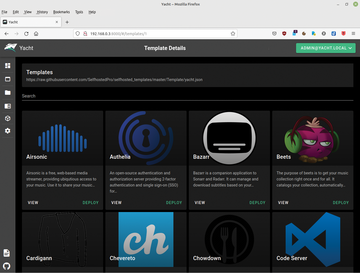Graphical management solutions for Docker
Starter Tools
Adding Containers
To add containers from the existing template list to the local system, select the Templates (folder icon) entry in the control bar on the left. In the window segment that opens, click the plus sign to the right of the Templates title. You are now taken to an input box where you need to enter a title and URL for the new template.
You can view the list of available templates on GitHub by simply copying the URL given at the top of the window into the corresponding input line and then clicking Submit below it. The software now jumps back to the template display and lists the template you just created as the first entry. Double-clicking on it displays a list of all templates available on GitHub; Yacht shows you a short description of each (Figure 10).
To create a container, simply click Deploy below the description of the respective template. You are then taken to a settings screen where the main options are already configured. Clicking Continue takes you to the next configuration screen, which also comes up with useful presets.
At the top of the settings dialog you will find a bar that shows how many dialogs you need to go through to customize the container. A green dot indicates the dialog that is currently open. Clicking on Continue takes you to the next dialog in each case. When you reach the last dialog, the Deploy button appears instead; use this to activate the fully deployed container. While the template is downloading, a bar at the top of the dialog indicates the progress.
When the container is deployed, the display jumps to the Applications category and lists the new application with some statistical data. The Apps display is similar to the container view in Portainer or Docker Desktop. The Resources | Images category lists the image associated with the newly created container, and the Volumes category lists the existing volumes.
In the Apps view you can also control the existing containers. You will find a small open triangle to the left of each container name. Clicking on a triangle opens a context menu with a set of typical controls. If necessary, you can use the Edit item to call up the original configuration dialog again and make adjustments to the container settings there. Once you are through all the setup dialogs, you can finally click on Deploy again to modify the container.
In the dashboard, Yacht then displays all the installed containers along with data on the most important operating parameters in a tiled view (Figure 11), so you can see at a glance whether the containers are all working as expected.
Conclusions
Although Docker is becoming more and more established as the leading container solution, you will find hardly any graphical solutions for managing smaller Docker installations on Linux (see the "Not in the Running" box). The three applications discussed are all fit for this purpose and offer a quick start, even in more complex Docker environments. All provide excellent documentation to guide newcomers step-by-step from setup to a working Docker instance in each graphical front end.
Not in the Running
Besides the candidates I looked at in this article, quite a few other tools are available on Linux for managing Docker environments. However, some of them are no longer under active development, such as DockStation [9] (last release 2019 [10]), Shipyard [11] (2016), and DockerUI [12] (also 2016). Lazydocker [13] and docui [14] are terminal applications. Although Lazydocker is still active, docui was discontinued in 2019.
Docker Desktop is a bit out of the ordinary because you install it separately on Linux as a native application. Portainer, a web-based solution that can be used universally on the intranet, is clearly ahead of the game. Yacht is the best choice for newcomers because it immediately lets you manage smaller Docker environments without serious training. User management would make Yacht's scope more flexible and is already in the works, according to the project.
Infos
- Docker Desktop: https://www.docker.com/products/docker-desktop/
- Docker Desktop documentation: https://docs.docker.com/desktop/install/linux-install/
- Docker Desktop licenses: https://www.docker.com/pricing/
- Portainer: https://www.portainer.io
- Portainer license models: https://www.portainer.io/pricing
- Portainer documentation: https://docs.portainer.io
- Yacht: https://yacht.sh
- Installing Yacht: https://yacht.sh/docs/Installation/Install
- DockStation: https://dockstation.io
- DockStation on GitHub: https://github.com/DockStation/dockstation
- Shipyard: https://shipyard-project.com
- DockerUI: https://github.com/kevana/ui-for-docker
- Lazydocker: https://github.com/jesseduffield/lazydocker
- docui: https://github.com/skanehira/docui
Buy this article as PDF
(incl. VAT)
Buy ADMIN Magazine
Subscribe to our ADMIN Newsletters
Subscribe to our Linux Newsletters
Find Linux and Open Source Jobs
Most Popular
Support Our Work
ADMIN content is made possible with support from readers like you. Please consider contributing when you've found an article to be beneficial.









